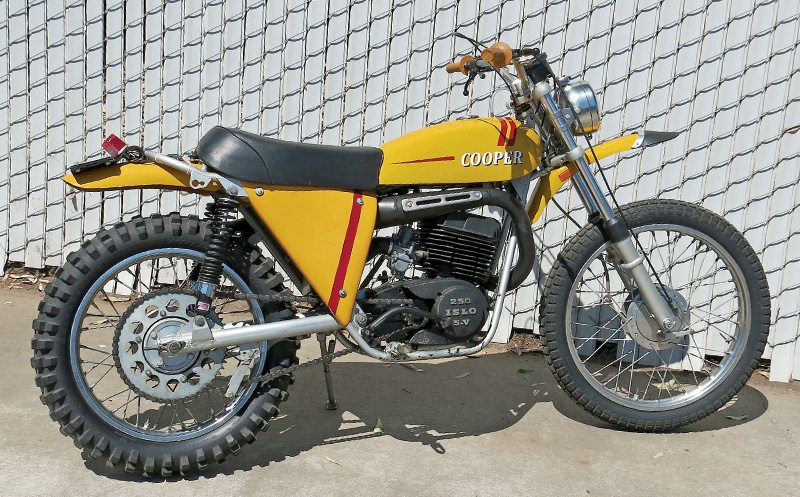
Back in those halcyon days of the early 1970s, two-stroke enduro models were the rage. If you wanted a play-bike, you bought Japanese.
If you were a serious rider, you bought European, as in Maico, CZ or Husqvarna. A California fellow by the name of Frank Cooper was the Maico distributor, and entertained himself on weekends by doing a bit of desert racing.
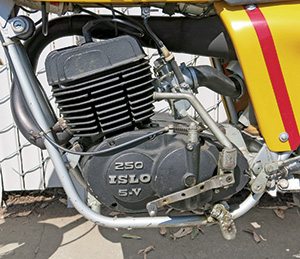
He appreciated the cost-effectiveness of the Japanese bikes, which tended to have rather twitchy frames, and the competitiveness of the Europeans, despite their many quirks which could easily put off a rider. Or throw him off, as the case may be. Frank decided he would develop an in-between machine, with a Euro-style chassis and reliable Japanese engine. And he could be his own boss, rather than listen to Maico’s directives.
This would require a factory—not something that Frank had in his backyard. But there was one down in Saltillo, Mexico, not far from the Texas border. It was Moto Islo, founded by one Isidro Lopez (Islo—first two letters of each name) back in 1955, where he began making little 50-to-200cc “tortilla” bikes for Mexican commuters and postmen, often using Italian and German engines in his own frames. The tortilla reference meant that these were everyday bikes, like tortillas were everyday food.
The story goes that Frank showed up in Saltillo with a Maico frame under one arm, a Yamaha DT 250 engine under the other, and asked Isidro if the factory could put the two designs together. Perhaps that is apocryphal—but it has the elements of truth. Because when the first Cooper 250 Enduro appeared at the Long Beach (California) Motorcycle Show in the late fall of 1972, there were distinct similarities.
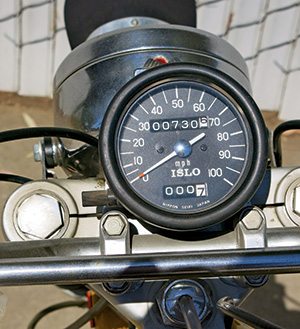
The Cooper certainly stood out, with a bright lemon yellow fiberglass gas tank, fenders and triangular side-panels. Steel rims held the Bridgestone knobby tires in place, with a 3.00 x 21 on the front, a 4.00 x 18 on the back. Quick-stopping brakes were not considered necessary on enduros, as they were expected to spend most of their time on the dirt, so smallish single-leading-shoe full-hub drums did the work.
Front suspension used a Mexican-made Betor telescopic fork, giving a healthy 7.7 inches of travel. The rear swingarm had a pair of Boge shock absorbers, with adjustable preload, which could be ordered with specific spring requirements depending on intended use. Frank had aimed his sights high, and wanted to see these bikes used not only in enduros, but also for motocross, desert racing, TTs and even short track…with the factory setting everything up according to the wishes of the buyer.
The frame was a full cradle with double downtubes, made of lightweight 4130 chromoly tubing; nothing inexpensive about that. Though the engine had a rather Yamaha-ish look about it, Islo was using its own reinforced 200cc crankcase, albeit with a DT-style top end. Everything from the connecting rod on up could be sourced from a Yamaha parts book if needed. It had the same 70mm bore and 64mm stroke of the 246cc DT; imitation is the sincerest form of flattery.
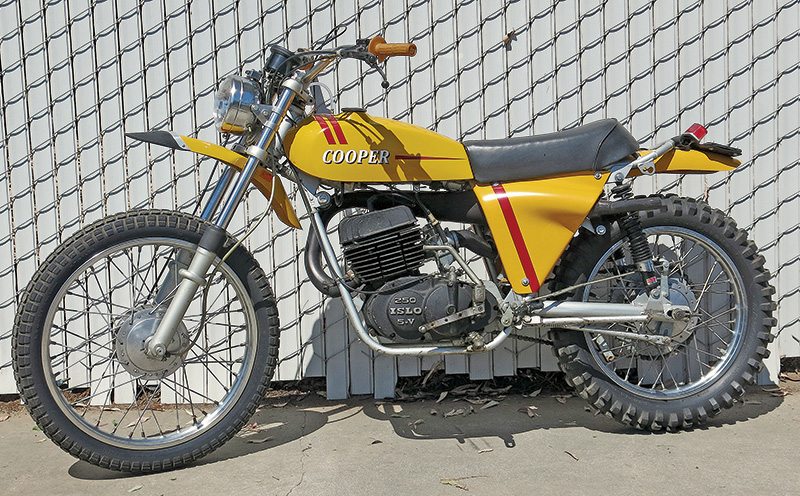
The big difference was in the carburetion, with Yamaha using its Autolube system to mix the oil and the gas, and the Cooper relying on the old-fashioned premix way, adding oil to the gas in the 2.5-gallon tank and then running it through a 32mm Mikuni. A washable-foam air cleaner sat between the side panels.
The spark to the plug was provided by a flywheel magneto, and for anyone choosing to use Champions, an N-3G Gold Palladium was the expensive way to go. Exhaust gases exited via an upswept pipe which had a heat shield where the rider’s right leg might touch, then ducked behind the side panel and the shock absorber to end close to the taillight.
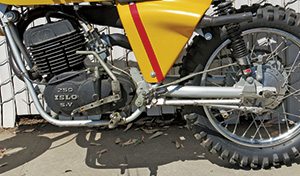
A duplex primary chain ran back to the close-ratio 5-speed gearbox, which looked very much like one on a CZ. In an entertaining bit of oversight, when the first bikes were given to the motorcycle press, the final gearing was such that the top speed could barely reach 50 mph; that was quickly changed.
Ground clearance was a reasonable 10 inches, with the seat at a tad over 31 inches. A reasonably comfy extended saddle kept the rider’s butt from protesting too much. A Nippon Seiko speedo went to an optimistic 100 mph. Dry weight was a claimed 227 pounds, with a wheelbase of 55 inches.
The first production bikes began appearing in U.S. shops in the spring of ’73, and riders were impressed with the power and the good handling. The engine, depending on tuning, was rated at anywhere between 23 and 28 horsepower. The factory had instructions for the serious contenders who wanted to increase performance, like reducing port timing on the piston-port engine by cutting four millimeters off the skirt of the piston. Or bolting on a 34mm carb.
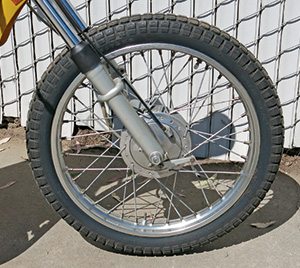
However, buyers were less impressed with the way the fenders cracked and various fasteners came unfastened. Islo had not been very attentive to the manufacture of the fiberglass, which was too brittle, nor to the metallurgy used in many of the fittings, and the quality-control people seemed to always be out on a break. Worst of all was the cracking of the chromoly frame, as the tubing apparently had not been heat-treated correctly.
When reports of these deficiencies came in, Frank was on the phone to the factory, as well as making personal visits. He told them to redo the frame in mild steel and double the wall thickness—which added some 20 pounds to the weight, but it did not break. Isidro told his workers that these bikes were America-bound, and Americans were intolerant of imperfections. The factory was still making primarily those tortilla bikes, with the Coopers being assembled on a separate line, and the best wrenches were soon working on the enduros. And making them better.
Second problem was price. Frank had been hoping to undercut the Japanese models, but his Coopers were turning out to be more expensive than he had figured. The owner of this Cooper still has his original 1973 bill of sale: $1,038. While a Yamaha DT3 250 of that year cost $859, Honda’s two-stroke MT 250, $870. At the other end, a CZ 250 Enduro cost $1,280.
The bad reputation dogged the Cooper even after the problems had been pretty much fixed, and combined with the high price this doomed the bike. After producing some 1,200 motorcycles the Cooper line just died.
(This Retrospective article was published in the November 2013 issue of Rider magazine.)








I can see a cross breed of. Montesa, Ossa and Bultaco.
But, bloody well done Mr Cooper. Riders need more of these European cross bred bikes. Don’t stop now.
Tony
I was a dealer back in the day the first 2 only 1/2 of the pars were there, we managed to put 1 together and Chuck Sun took it for a ride came back and said worst pig ever was a heavy slow turd I sent them back to Frank Cooper
I had a Cooper 250 Enduro, bought second hand from a guy that wasn’t too impressed with it. I was quite young at the time. Paying $200 for it. The guy I bought it from said the bike had issues with firing up, there was no carby air snorkel or filer cage on it at the time. Took off one of my socks and wrapped and tide around the carby inlet so I could ride it home. Occasionally it would cut out and hard to get going again, went through several spark plugs, replacing them with the same CHAMPION plugs that were in the bike when I bought it, not realizing it was the wrong plug in the first place changing it to a NGK plug was a whole different ball game. I later made up a filter box and ran some radiator hose to act a snorkel. Played around with the tuning and it was, what I thought at the time a great bike with plenty of power for my dirt trail riding. That was my first motorbike. Loved it.
I have a 1974 Cooper and yes it is hard to start. What NGK plug are you using?
Murray Turner